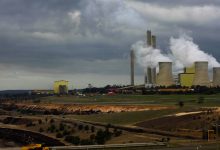The state of Victoria was hit by significant power cuts on Tuesday – in the middle of a heatwave – as storms blew down multiple transmission towers, causing major transmission lines to trip and taking out the biggest coal generator and some renewable plants.
The Australian Energy Market Operator on Tuesday declared a “significant power system event” and ordered up to 300 MW of capacity to be cut from customers in an attempt to restore stability to the grid.
Around 90,000 customers were affected by “load shedding” but another 500,000 customers lost power due to local network issues caused by the extreme weather.
The dramatic events on the wholesale market were triggered by falling transmission lines, believed to have been blown down in a storm, soon after 2.08pm (AEDT).
Some 2690 MW of generation was almost immediately lost, including the giant Loy Yang A brown coal generator in the Latrobe Valley, and 1,000 MW of load was also lost. AEMO then instructed the 300 MW of load to be “shed” around 3.20pm (AEDT), before gradually restoring that load less than an hour later.
The event had an immediate impact on wholesale electricity markets, with prices in Victoria and Tasmania surging to the market cap of $16,600/MWh. Frequency plummeted.
AEMO followed with a warning of a “lack of reserve 2” for the afternoon, called for emergency reserves from the market and then announced that transmission company AusNet had been instructed to implement “load shedding” to protect the grid.
- “To keep the power system secure, AEMO has directed AusNet Services to enact load shedding,” it said in a statement.
- “Controlled load shedding is a mechanism AEMO uses as an absolute last resort to protect system security and prevent long-term damage to system infrastructure.”
The events appear to have had a cascading effect through the grid, with the interstate links to South Australia and NSW also tripping, least temporarily. The Basslink from Tasmania was working, however, with prices in that state also jumping to the market cap as it exported power to the mainland.
The tripping of the Moorabool line also had an impact on other generators, with the Stockyard Hill and Dundonnell wind farms also falling to zero output without an operating link into the grid. Together they had been injecting more than 600 MW into the grid before the disruption.
Two of the four units at the Yallourn generator were also off line, presumably for maintenance. One of the units had only been taken off line on Monday afternoon.
The surge in price also created a lot of activity for the state’s big batteries – the Victoria Big Battery, the Hazelwood battery, and the Bulgana, Gannawarra and Ballarat batteries.
Tesla’s local head of energy Josef Tadich was also quick to point out the speed with which household batteries – particularly those participating in virtual power plants – had responded to the event and support the power system.
“You can see below my own system participating in a VPP (so I can share the data!) happily covering load and exporting at 5kW, and letting the customer know what it’s doing with a “Grid Services” notification,” he wrote on LinkedIn.

“As not all customers are energy nerds (and) constantly checking the power price, it’s important that customers are engaged and share in the reward for their system’s participation.”
Tadich says that such events will become increasingly common – particularly as fossil plants age and heatwaves become more common – and community energy resources such as household solar and battery storage, and EVs will have a greater role to play in supporting the system.
An AGL spokesman confirmed that all four Loy Yang A units went offline at 2.15pm (AEDT).
“We are currently investigating the cause,” he said in an emailed statement. “We will provide another update in one hour.”
In a later statement, AGL said work was underway to restore three of its four units, pending the resolution of transmission line issues.
- “Following today’s tripping of transmission lines that led to the unplanned outage, work is underway to return units back to service,” AGL said.
- “This will take place over the next few hours in line with our safety and operational protocols, and as associated transmission line issues are resolved.”
Environmental Justice Australia senior specialist lawyer Charley Brumby-Rendell said the blackouts are a reminder that the roll-out of renewable energy needs to be fast-tracked.
“National Pollution Inventory data shows coal fired power stations are producing less power but remain one of the biggest sources of toxic air pollution in Australia. These coal-fired power stations are unreliable, dirty old clunkers,” he said.
“After the hottest January on record, we need to ramp up investments in renewable energy, increase reliability in the grid and ensure that Loy Yang A can close and stop polluting our air even sooner.”









